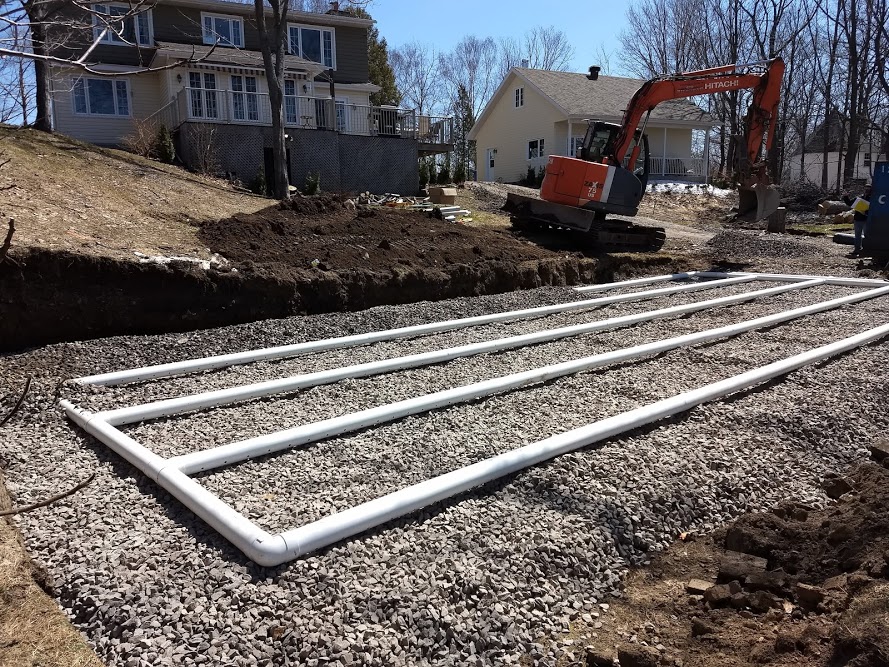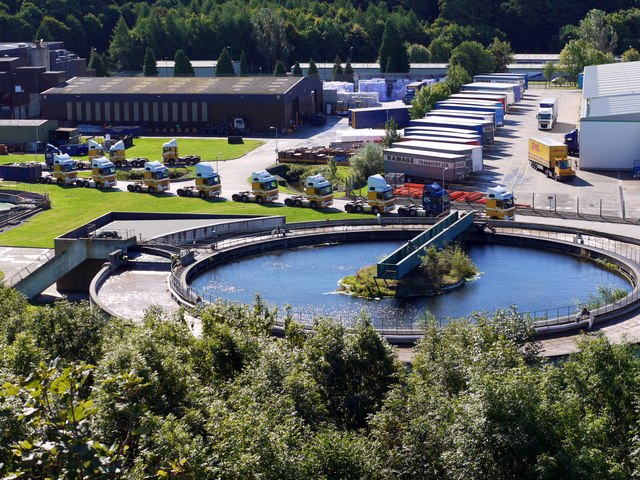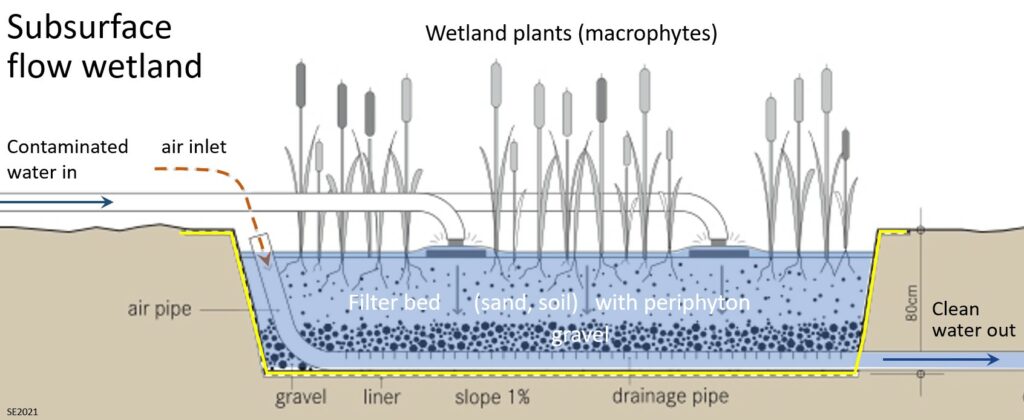14.5 Liquid Wastes
The solids in our waste include feces, food particles, toilet paper, grease, oil, soaps, dissolved salts and metals, and mineral matter (sand, clay etc.). Those components give wastewater chemical characteristics similar to those summarized in Table 14.5.1.[1]
| BOD5 | COD | Organic Carbon | Total Suspended Solids | Volatile Suspended Solids | Carbonates | N | P | Fats, Oils & Grease |
| 305 | 740 | 250 | 450 | 320 | 37 | 80 | 23 | 100 |
- Bacteria (including: Escherichia, Salmonella, Shigella, Campylobacter and Vibrio cholerae)
- Viruses (including: hepatitis, rotavirus, coronavirus, enterovirus)
- Protozoa (including: Entamoeba, Giardia and Cryptosporidium)
- Parasitic worms and their eggs
Wastewater Treatment
- The main goal of primary treatment is to separate the solids from liquids, and that is achieved first using screens (with openings of around 1 cm) to remove larger particles and then settling tanks to separate the smaller suspended material. Any material that floats is removed from the surface. The sludge that settles to the bottom is separated and can be further processed by fermentation or digestion with bacteria. Methane is produced during this process, and that can be used as fuel. Primary treatment typically removes about half of the BOD and the fecal coliforms and most of the suspended solids.
- During secondary treatment the wastewater is aerated and differing bacteria are added at different stages to break down the organic matter. About 85 to 90% of the BOD and suspended solids, along 90 to 99% of the coliform bacteria are removed at this stage. The water may then be filtered and disinfected with chlorine, ozone or UV light before being released to the environment.
- Tertiary treatment involves bioreactors with different levels of oxygenation and bacteria, or with specific chemical processes to remove dissolved components, especially phosphorous and nitrogen so that the released water doesn’t contribute to algal growth. This end-stage water may also be filtered and disinfected with chlorine, ozone or UV before being released to the environment.
An example of a wastewater treatment plant is illustrated on Figure 14.5.1. The round structures are aeration and settling tanks.

Most residents of rural areas are not connected to sewage collection piping networks and so are required to deal with their own wastewater (or else have it taken to a treatment plant in a tanker). The most common solution is a septic tank with a drainage field. The septic tank is typically a plastic or concrete tank with two chambers that is designed so that most of the solids can settle and the scum that develops on top of the wastewater is constrained. The liquid is allowed to flow to a drainage field similar to the one shown on Figure 14.5.2. The key features to note are that the plastic pipes have perforations to allow the liquid to drain out, and that a layer of permeable gravel has been placed in order to allow the liquid to drain slowly and enter the underlying soil or permeable rock. The premise behind an installation of this type is that as the water seeps slowly through the drainage medium and then the underlying natural soil and/or rock it will become sufficiently clean so that it won’t seriously contaminate the nearest body of surface water. For that reason, it is important to assess permeability and porosity of the natural materials present in the area where a drainage field is to be constructed. If the permeability is too high the wastewater may flow through too quickly to be effectively treated. If the permeability is too low the wastewater may not flow away at all, and instead will pool on the surface.
Exercise 14.4 What Happens to Your Wastewater?

It’s good practice to be aware of what happens to our waste—both solid and liquid!
Before it is released to the natural environment effluent from a wastewater treatment plant, runoff from a road, or “grey water” from a kitchen or shower can be further decontaminated in a wetland. A constructed wetland is situated within a natural or excavated basin that has an impermeable liner. It has a perforated plumbing system at the base embedded in permeable gravel which is covered with finer material (Figure 14.5.3). Wetland plants (a.k.a. macrophytes) are grown within the wetland, but their primary function is to provide a substrate (roots, stems and leaves) and appropriate chemical conditions for a population of microorganisms (algae, bacteria etc.) called a periphyton. The periphyton is responsible for removal of about 90% of the pollutants. Well-designed constructed wetlands are effective in removing nitrogen, phosphorous and trace metals and in reducing BOD and COD levels.

Media Attributions
- Figure 14.5.1 Marlborough East Wastewater Treatment Plant by Nick Allen, 2015, CC BY SA 4.0, via Wikimedia Commons, https://commons.wikimedia.org/wiki/File:Marlborough_East_Wastewater_Treatment_Plant_Aerial.JPG
- Figure 14.5.2 Drain Field in Progress by Nonztp, 2019, CC BY SA 4.0, via Wikimedia Commons, https://commons.wikimedia.org/wiki/File:Drain_field_in_progress.jpg
- Figure 14.5.3 NZ0963: Waste water treatment works and transport depot, Low Prudhoe by Andrew Curtis, CC BY-SA-2.0, via Geograph, https://www.geograph.org.uk/photo/2039001
- Figure 14.5.4 Steven Earle, CC BY 4.0, after Tilley, E, et al. (2014). Compendium of sanitation systems and technologies (2nd edition). Swiss Federal Institute of Aquatic Science and Technology, via Wikimedia Commons, https://commons.wikimedia.org/wiki/File:Tilley_et_al_2014_Schematic_of_the_Vertical_Flow_Constructed_Wetland.jpg
- From the Technische Universitat Hamburg (accessed May 2021), https://cgi.tu-harburg.de/~awwweb/wbt/emwater/lessons/lesson_a1/lm_pg_1066.html ↵
- From: Wikipedia contributors. (2021, November 22). Sewage. In Wikipedia (accessed May 2021). https://en.wikipedia.org/wiki/Sewage ↵
- Berman, J. (2009, October 29). WHO: Waterborne disease is world's leading killer (accessed May 2021). Center for Strategic and International Studies. https://www.voanews.com/archive/who-waterborne-disease-worlds-leading-killer ↵
- Safe Drinking Water Foundation. (n.d.). Wastewater treatment: Wastewater treatment fact sheet. https://www.safewater.org/fact-sheets-1/2017/1/23/wastewater-treatment (Accessed May 2021) ↵
- Pescod, M.B. (1992). Wastewater treatment and use in agriculture - FAO irrigation and drainage paper 47. Food and Agriculture Organization. http://www.fao.org/3/t0551e/t0551e00.htm#Contents (Accessed May 2021) ↵

